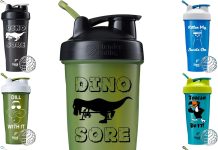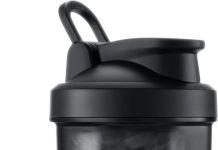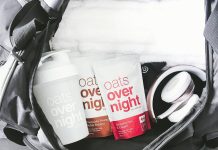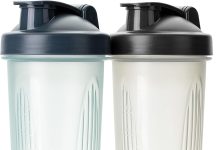Ah, the age-old question we’ve all asked ourselves at one point or another: are Blender Bottles freezer safe? Well, fear not, dear friends, for today we shall unravel the mystery surrounding this vital piece of information. It’s a query that has been haunting our minds every time we reach for our trusty Blender Bottle and ponder whether it can withstand the icy depths of our freezer. So, grab your favorite beverage and join us on this journey as we uncover the truth about Blender Bottles and their compatibility with freezing temperatures.
Review contents
Materials used in Blender Bottles
When it comes to blender bottles, there are several materials that are commonly used in their construction. These materials include plastic, glass, stainless steel, and silicone. Each material has its own unique properties and benefits, making it important to understand the differences between them.
Plastic
Plastic is one of the most common materials used in blender bottles. It is lightweight, durable, and easy to clean, making it a popular choice for many individuals. However, not all plastics are created equal. Some blender bottles are made from low-quality plastics that may leach chemicals into your beverages. It’s important to choose blender bottles made from BPA (Bisphenol A) and phthalate-free plastic, as these are deemed safer for food and beverage consumption.
Glass
Glass blender bottles offer a sleek and stylish option for those who prefer a more traditional look. Glass is known for its excellent durability and resistance to staining and odors. It is also non-toxic and does not leach any harmful chemicals into your drinks. However, glass can be heavier and more fragile than other materials, so it is important to handle and store glass blender bottles with care.
Stainless Steel
Stainless steel blender bottles are known for their superior insulation properties. These bottles are often double-walled, which helps to keep your beverages cold for extended periods of time. Stainless steel is also highly durable and resistant to rust and corrosion. Additionally, stainless steel blender bottles are free from any harmful chemicals and can be easily cleaned.
Silicone
Silicone blender bottles are relatively new to the market but have quickly gained popularity. Silicone is a flexible and durable material that is resistant to high and low temperatures. It is also lightweight and easy to clean. Silicone blender bottles are considered safe for freezer use and provide a great alternative for those who prefer a soft and squeezable bottle.
Understanding Freezer Safety
Before you start freezing your blender bottles, it’s important to understand the principles of freezer safety. Freezing can have a significant impact on the materials used in blender bottles, so it’s crucial to know the temperature limits, the effects of expansion and contraction, the impact on material durability, and any potential health concerns.
Temperature Limits
Blender bottles are designed to withstand a wide range of temperatures, but it’s important to know their limits. Before freezing a blender bottle, make sure to check the manufacturer’s recommendations for safe freezer usage. Exceeding the recommended temperature limits can compromise the integrity of the bottle and lead to breakage or cracking.
Expansion and Contraction
When liquids freeze, they expand. This expansion can put stress on the materials used in blender bottles, especially plastic and glass. It’s important to leave enough headspace in the bottle when freezing to accommodate this expansion and prevent the bottle from cracking or breaking.
On the other hand, when the frozen contents start to thaw, they contract. This contraction may cause the bottle to collapse if it is not made from a flexible material like silicone. Be aware of this possibility and take necessary precautions when thawing your frozen beverages.
Effect on Material Durability
Freezing can have varying effects on the durability of different materials. Glass and stainless steel are generally more resistant to the damaging effects of freezing and thawing. However, plastic and silicone materials may become more brittle over time when exposed to extreme temperature changes. It’s important to handle your blender bottles with care and check for any signs of damage or deterioration before and after freezing.
Health Concerns
When it comes to freezing liquids in blender bottles, health concerns may arise due to the potential leaching of chemicals from certain materials. To ensure the safety of your beverages, it is recommended to choose blender bottles made from BPA and phthalate-free plastic, as well as those made from food-grade silicone or stainless steel.
Plastic Blender Bottles
Plastic blender bottles are a popular choice due to their affordability and practicality. However, not all plastic blender bottles are created equal. Let’s take a closer look at the different types of plastic materials used in blender bottles, as well as the importance of BPA and phthalate-free options.
Types of Plastic Materials
Plastic blender bottles can be made from a variety of materials, including polypropylene (PP), polyethylene terephthalate (PET), and high-density polyethylene (HDPE). Each material has its own unique properties, such as heat resistance, durability, and transparency. It’s important to choose a plastic blender bottle made from a material that suits your specific needs and preferences.
BPA and Phthalate-Free
Bisphenol A (BPA) and phthalates are chemicals that are commonly used in the production of plastics. However, there are growing concerns about the potential health risks associated with these chemicals. BPA has been linked to hormonal imbalances and other health issues, while phthalates have also raised concerns regarding their impact on reproductive health.
To mitigate these risks, many manufacturers now produce blender bottles that are labeled as BPA and phthalate-free. These bottles are made from plastics that do not contain these harmful chemicals, providing users with peace of mind when it comes to their health and safety.
Cold Temperature Resistance
Plastic blender bottles, especially those made from high-quality materials like PP and HDPE, are generally resistant to cold temperatures. They can be placed in the freezer without any immediate risk of damage. However, it’s important to note that repeated exposure to extreme cold and rapid temperature changes may affect the overall durability of the plastic material over time.
Glass Blender Bottles
Glass blender bottles offer a unique and elegant alternative to their plastic counterparts. Let’s explore the different aspects of glass blender bottles, such as the type of glass used and their resistance to extreme temperatures.
Glass Type
Glass blender bottles are typically made from borosilicate or soda-lime glass. Borosilicate glass is known for its exceptional strength, durability, and resistance to thermal shock. It is often used in high-quality blender bottles that are designed to withstand extreme temperature changes. Soda-lime glass, on the other hand, is more affordable but may be more prone to breaking when exposed to rapid temperature changes.
Glass Thickness
The thickness of the glass used in blender bottles can vary. Thicker glass is generally more resistant to breakage and can withstand greater temperature fluctuations without any issues. Thinner glass, while more lightweight, may be more prone to cracking or breaking when subjected to extreme temperatures.
Resistance to Extreme Temperatures
Glass blender bottles are known for their excellent resistance to extreme temperatures. They can be safely placed in the freezer, allowing your beverages to cool rapidly without the risk of any chemical leaching. Glass bottles also retain the cold temperature for longer periods, ensuring that your drinks stay refreshingly chilled.
However, it’s important to handle glass blender bottles with care, especially when thawing frozen beverages. Rapid temperature changes may cause the glass to crack or shatter, so be sure to allow for a gradual thawing process to prevent any accidents.
Stainless Steel Blender Bottles
Stainless steel blender bottles offer superior insulation properties, making them a popular choice for those who want to keep their beverages cold for extended periods of time. Let’s dive into the features and benefits of stainless steel blender bottles.
High-Quality Insulation
Stainless steel blender bottles are designed to keep your drinks cold for hours. The double-wall construction of these bottles acts as an effective insulator, preventing the transfer of heat from the outside environment to your beverage inside. This insulation feature makes stainless steel blender bottles perfect for use during workouts, outdoor activities, or simply for enjoying a refreshing drink on a hot day.
Double-Wall Construction
The double-wall construction of stainless steel blender bottles creates a vacuum-sealed space between the inner and outer walls, further enhancing the insulation properties. This design not only keeps your beverages cold but also prevents condensation from forming on the outside of the bottle, eliminating the need for coasters or drink sleeves.
Cold Retention
Stainless steel blender bottles can keep your drinks cold for an extended period, sometimes up to 24 hours or more. This is especially beneficial for individuals who are constantly on the go or prefer to sip their beverages gradually throughout the day. The cold retention feature ensures that your drink remains at the perfect temperature, allowing you to enjoy it at your own pace.
Silicone Blender Bottles
Silicone blender bottles offer a unique combination of flexibility, durability, and temperature resistance. Let’s take a closer look at the benefits and features of silicone blender bottles.
Temperature Resistance
Silicone is a material that is known for its exceptional temperature resistance. It can withstand both high and low temperatures without any issues. Silicone blender bottles can safely be placed in the freezer without the risk of cracking or breaking. This makes them an excellent choice for individuals who want the flexibility to freeze their beverages and enjoy them on-the-go.
Flexibility and Durability
Silicone blender bottles are highly flexible and can be easily squeezed to dispense your drinks. This feature makes them convenient for athletes, travelers, and anyone who leads an active lifestyle. Silicone is also a durable material that can withstand repeated use without losing its shape or integrity. You can trust that your silicone blender bottle will provide long-lasting performance and withstand the rigors of daily use.
Safe for Freezing
Silicone blender bottles are considered safe for freezing due to their temperature resistance and flexibility. The material does not release any harmful chemicals or toxins into your beverages when exposed to extreme temperatures. Whether you’re freezing smoothies, protein shakes, or other beverages, you can rely on silicone blender bottles to keep your drinks chilled and ready to enjoy.
Tips for Freezing with Blender Bottles
Now that you have a better understanding of the materials used in blender bottles and their freezer safety, here are some helpful tips to ensure a successful freezing experience:
Leave Adequate Head Space
When freezing your beverages in a blender bottle, it’s crucial to leave enough room for expansion. Liquids expand when they freeze, and if you overfill the bottle, it may burst or crack. As a general rule, leave about 1 to 2 inches of headspace at the top of the bottle to allow for expansion.
Avoid Overfilling
While leaving headspace is important, it’s equally vital to avoid overfilling your blender bottle. Overfilling can lead to difficulties when securing the lid, cause leaks or spills when frozen, and even result in the bottle bursting as the liquid expands. Follow the fill line markings on the bottle or use your judgment to ensure a safe and hassle-free freezing process.
Secure Lid Properly
To prevent any unwanted spills or leaks, make sure to securely fasten the lid on your blender bottle before placing it in the freezer. A tightly sealed lid will not only prevent your beverages from spilling out but will also help maintain the cold temperature inside the bottle throughout the freezing process.
Do Not Freeze Carbonated Beverages
It’s important to note that carbonated beverages, such as carbonated water or soda, should not be frozen in blender bottles. The carbonation causes a buildup of pressure, which can lead to an explosion when the liquid expands during freezing. To enjoy carbonated beverages on-the-go, it’s best to add the carbonation after thawing your drink or opt for an alternative container.
Gradual Thawing Process
When it’s time to enjoy your frozen beverage, it’s important to allow for a gradual thawing process. Rapid temperature changes can cause stress on the materials of the blender bottle, especially plastic and glass. To prevent any potential damage, place the frozen bottle in the refrigerator and let it thaw slowly overnight. This gradual thawing process ensures that your drink will be ready to enjoy without compromising the integrity of the blender bottle.
Benefits of Freezing with Blender Bottles
Freezing your beverages in blender bottles offers several benefits that can enhance your overall experience. Let’s explore some of the advantages of freezing with blender bottles:
Convenience
Blender bottles provide a convenient way to freeze and store your beverages. They are designed to be portable and easy to carry, allowing you to take your frozen drinks with you wherever you go. Whether you’re heading to the gym, going on a hike, or simply want a refreshing drink on a hot day, a frozen blender bottle ensures that you have a chilled beverage ready to enjoy at any time.
Meal Prepping
Freezing with blender bottles can be a great tool for meal prepping. You can prepare batches of smoothies, protein shakes, or other beverages in advance and freeze them in individual blender bottles. This allows you to save time and effort by having ready-to-drink meals and snacks available whenever you need them. Simply grab a frozen blender bottle from the freezer, let it thaw, and you have a nutritious and satisfying meal on the go.
Preserving Freshness
Freezing your beverages in blender bottles helps to preserve their freshness and flavor. By freezing your drinks, you can extend their shelf life and ensure that they stay fresh for longer periods. This is especially beneficial for individuals who enjoy making large quantities of smoothies or other beverages and want to avoid waste.
On-The-Go Nutrition
Blender bottles are not just for shakes and smoothies. Freezing with blender bottles allows you to conveniently store and transport a variety of nutritious beverages, such as iced coffee, infused water, or homemade energy drinks. Having these options readily available ensures that you can maintain a healthy and balanced diet, even when you’re on the go.
Additional Uses of Blender Bottles in Freezing
In addition to freezing beverages, blender bottles can be used in various other ways to enhance your freezing experience. Here are a few additional uses for blender bottles in the freezer:
Making Frozen Smoothies
Blender bottles are designed to simplify the process of making smoothies, and they can also be used to freeze them. Once you’ve prepared your favorite smoothie blend, pour it into a blender bottle and place it in the freezer. This allows you to enjoy a refreshing frozen smoothie whenever you desire. Simply remove the bottle from the freezer, let it thaw slightly, and enjoy a delicious and creamy smoothie on the go.
Creating Flavored Ice Cubes
Blender bottles can also be used to freeze flavored ice cubes. Whether you want to add a burst of flavor to your water or create unique and fun ice cubes for your cocktails, blender bottles provide a convenient solution. Simply fill the bottle with your desired liquid, such as fruit juice or infused water, and freeze. The resulting flavored ice cubes can be added to your favorite beverages for an extra touch of flavor and visual appeal.
Preparing Frozen Protein Popsicles
For those who enjoy a cold and protein-packed treat, blender bottles can be used to prepare frozen protein popsicles. Mix your favorite protein powder with a liquid of your choice, such as almond milk or yogurt, and pour the mixture into a blender bottle. Place the bottle in the freezer and let it freeze until solid. Once frozen, remove the bottle, run it under warm water to loosen the popsicle, and enjoy a nutritious and refreshing treat.
Chilling Homemade Sauces and Dressings
Blender bottles can also be used to store and chill homemade sauces and dressings in the freezer. These containers are ideal for preventing spills and leaks, and their compact size makes them easy to store. Whether you’re making a batch of homemade tomato sauce or a delicious salad dressing, simply pour it into a blender bottle, seal the lid tightly, and freeze. When you’re ready to use the sauce or dressing, simply remove the bottle from the freezer, allow it to thaw slightly, and scoop out what you need.
Conclusion
Blender bottles are indeed freezer safe, providing you with a versatile and convenient way to freeze and store your favorite beverages. Whether you choose a plastic, glass, stainless steel, or silicone blender bottle, make sure to follow the recommended temperature limits and freezing guidelines for each material. With proper care and attention, you can enjoy the benefits of freezing with blender bottles, including convenience, meal prepping, preserving freshness, and on-the-go nutrition. So go ahead, freeze your favorite drinks, and enjoy a refreshing and chilled beverage whenever and wherever you please. Cheers to a cool and convenient way to stay hydrated!





































